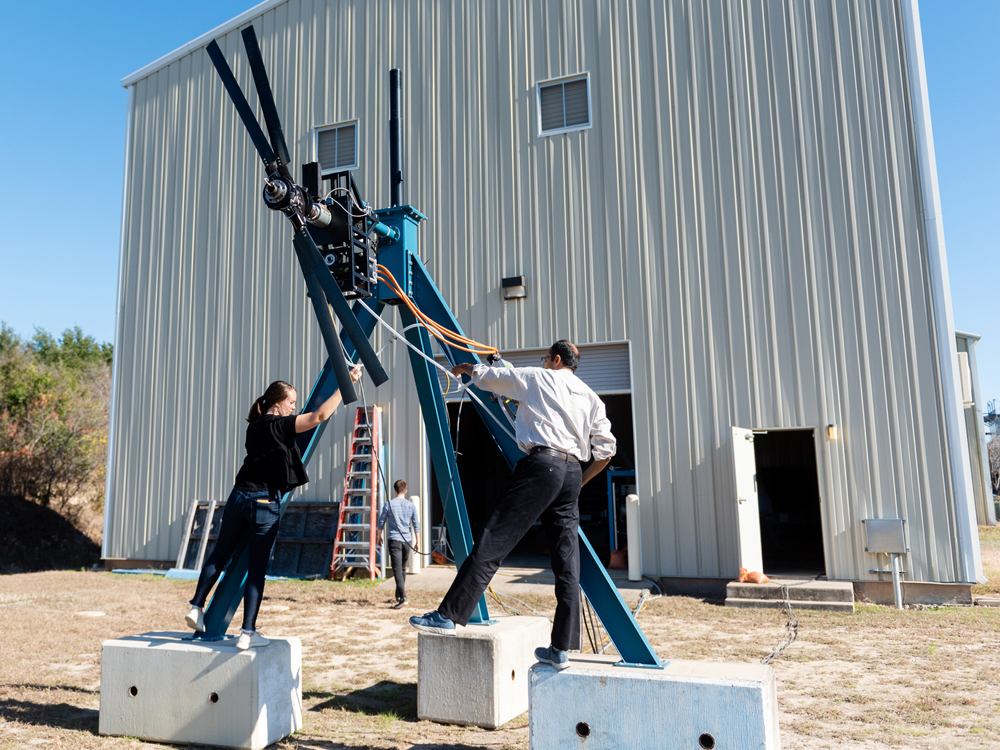Chloe Johnson pivoted between three computer monitors alongside fellow graduate student, Patrick Mortimer, as she powered the rotor testing rig, tucked away in a non-descript hangar on UT Austin’s J.J. Pickle Research Campus. The adjoining room soon filled with the glow of green lasers, perfectly placed to capture the rate at which particles from a fog machine illuminated by lasers pass through two propeller blades – data that will be crucial to the future of urban air mobility.

A graduate student in aerospace engineering, Johnson is no stranger to uncrewed aerial vehicle (UAV) and vertical take-off and landing (VTOL) equipment. After receiving her B.S. in engineering mechanics from the University of Wisconsin-Madison, she moved to Austin to pursue her master’s aerospace engineering from the Cockrell School of Engineering. Her research focuses primarily on exploring the efficiency and noise production of coaxial propellers for VTOL, as part of a research partnership with the U.S. Army Research Labs and Uber Elevate, to help develop the rotor technology for vehicles that will be used in Uber’s proposed aviation ride-share network called uberAir.
“We have two rotors on a single shaft, called a ‘stacked rotor,’ and, as those rotate together, we alter the geometry between them to measure changes in performance and acoustics,” Johnson said. “We are working to increase urban air mobility while decreasing the sound pollution that comes with it. I’d love to see air taxis flying everywhere in 10 to 15 years, but I wouldn’t want to hear them.”
The research partnership was announced in August 2018 following a push to reduce the decibels produced by flying vehicles – a transportation method expected to be made commercially available in select cities by 2023. Jayant Sirohi, associate professor in the Cockrell School’s Department of Aerospace Engineering and Engineering Mechanics, is the UT principal investigator for the project.

“Our end goal is for this data and technology to be used in an uberAIR taxi or similar UAV,” Johnson said. “Our advisor, Dr. Sirohi, always says it’s like five days of work and then two minutes of hold-your-breath excitement as you test your work. That’s the fun part of experimental research – you finally hit ‘go’ and see how everything runs, trusting yourself that you did everything right to prepare for that moment.”
Those two-minute segments of “hold-your-breath excitement” will provide the answers to solving our nation’s heavy congestion issues in major metropolises. A trip south of the river in Austin, for example, could be a mere 10-minute flight, as opposed to the current hour or more we usually face while stuck in heavy traffic.
As Sirohi’s team sifts through their daily data, working to solve traffic congestion issues, reduce the use of fossil fuels through electric vehicles and decrease the level of decibels produced from air transportation, Johnson said she’s excited for the future of urban air transportation.
“Mobility as we know it will be completely different in just a few years,” Johnson said. “I want this technology to be accessible to everybody. I will soon get to see that dream become a reality, and it’s exciting to know I’m playing a part in it.”
Johnson was recently selected by Aviation Week Network and the American Institute of Aeronautics and Astronautics (AIAA) for its 20 Twenties award program for 2020 for her work on the air taxi project.
